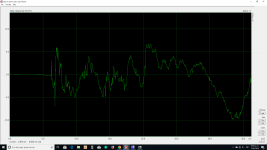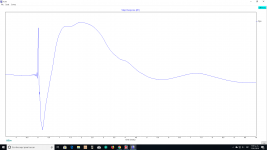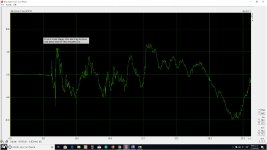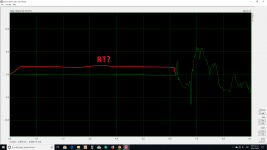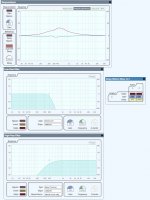Your present step response can actually be read: <snip>
Is enough Chris?
Attachments
Apart from that unexplained negative-going spike your step response looks quite reasonable for that crossover. There is the positive peak from the tweeter, followed by the negative-going part of the midrange after approximately 150 us and again the positive-going response from the woofer after about 700 us.
The only strange thing is that negative spike. The raggedness comes from reflections and diffraction.
Regards
Charles
The only strange thing is that negative spike. The raggedness comes from reflections and diffraction.
Regards
Charles
Maybe if the OP could share his frd and zma files, we could take a crack at it.
Also, what is the step response from the XO in XSim?
Attached FRD & ZMA files with step response of Xsim.
Attachments
There is the positive peak from the tweeter, followed by the negative-going part of the midrange after approximately 150 us and again the positive-going response from the woofer after about 700 us.
The only strange thing is that negative spike. The raggedness comes from reflections and diffraction.
Regards
Charles
Be careful when making conclusions like this. You may make a misinterpretation easily.
Do you live in a cement square box?
Yikes!
Even though there might be ways to clean up the XO, your room needs a lot of treatment before attempting to fix anything else.
In this case, the room is much more the culprit than any XO you can come up with.
Yikes!
Even though there might be ways to clean up the XO, your room needs a lot of treatment before attempting to fix anything else.
In this case, the room is much more the culprit than any XO you can come up with.
Attachments
Be careful when making conclusions like this. You may make a misinterpretation easily.
But my conclusions are quite close to what the maths predict for this crossover. You may be correct for my conclusion regarding the ragedness because the drivers themselves can also be guilty.
Regards
Charles
Mark100, I agree with you regarding FIR would sound less flat than IIR in many cases. In my setup, short FIR sounded worse than long FIR, especially at low frequency. I still use FIR for crossover and correction EQ, but they are not linear phase. I'm now curious analog active vs FIR...
Is enough Chris?
Yes, thanks.
I believe that moving the tweeter back in each case by 25 cm will do a lot to close that step response down toward your desired (perfect) response.
I will second the comment about the noisiness of the room's portion of the step response by adding some absorption and perhaps diffusion, as well as adding extra absorption on the floor temporarily from the microphone to the loudspeaker and about 2 m wide--like a blanket, quilt or thick sound/thermal insulation material. I've found that this really helps with capturing the phase response of the loudspeaker.
Just as an aside, I've found that the impulse spectrogram view shows even more in terms of impulse response--for instance, a Cornwall spectrogram showing the effect of the long midrange horn/driver relative to the tweeter and direct-radiating woofer, nominally crossed at 4.9 kHz and 600 Hz:
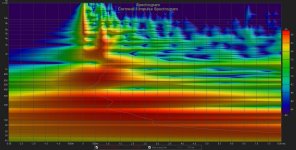
The delay due to the crossover in your loudspeakers will also show similar effects in impulse spectrograms (as evidenced by the present step response), although probably less pronounced than the above at about half the time delays shown, plus a smearing of the HF tweeter energy due to that negative-going pulse so soon after the direct arrival pulse.
Chris
Apart from that unexplained negative-going spike your step response looks quite reasonable for that crossover. There is the positive peak from the tweeter, followed by the negative-going part of the midrange after approximately 150 us and again the positive-going response from the woofer after about 700 us.
The only strange thing is that negative spike. The raggedness comes from reflections and diffraction.
Regards
Charles
I have no-time-aligned 3 way vintage horn speaker that impulse response looks like this. The impulse made me so nervous, but frequency response is good, and in fact, this speaker has a lovely vintage tone. 🙂
Thank you Chris. In place of "moving the tweeter back in each case by 25 cm" can be done increasing the R1 value to attenuate the tweeter?
Felipe
Felipe
Last edited:
Thank you Chris. In place of "moving the tweeter back in each case by 25 cm" can be done increasing the R1 value to attenuate the tweeter?
Felipe
25 cm corresponds to a duration (time), not a level.
//
Yes, the crossover filters in your crossovers introduce time delays as a function of frequency that reach a steady state phase at some point above and below the crossover frequency (the second plot, below). In order to get an ideal step response that you wanted, you have to offset the higher frequency drivers farther away from the listener to achieve flat phase to get that step response:
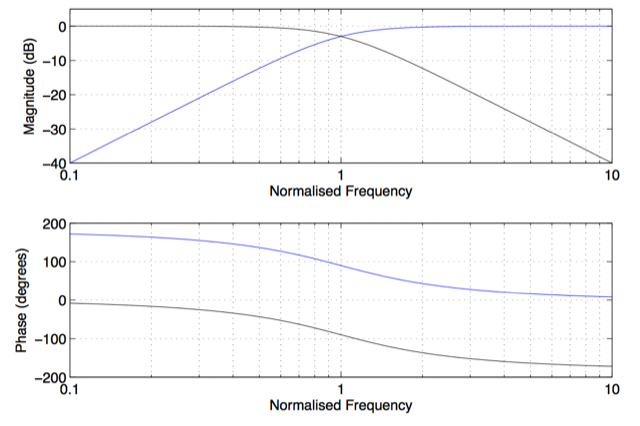
The higher the order of the filters used, the greater the phase growth that must be compensated by adding time delays on the HF drivers.
Chris

The higher the order of the filters used, the greater the phase growth that must be compensated by adding time delays on the HF drivers.
Chris
Hi Chris, I don't understand what you're saying...
It seems like you are saying to use delay to overcome phase rotation (group delay), but i know that can't be right....you must be saying something else...
What kind of crossovers were you referring to?
It seems like you are saying to use delay to overcome phase rotation (group delay), but i know that can't be right....you must be saying something else...
What kind of crossovers were you referring to?
It seems like you are saying to use delay to overcome phase rotation (group delay), but i know that can't be right....you must be saying something else...
As I understand, this is what he meant. But that can at best be a coarse approximation. If it were that easy we would only see transient perfect crossovers.
Regards
Charles
You know, sometimes it seems difficult to state the simplest things here...😉
Here is an excerpt from the Harsch crossover thread:
Here is an excerpt from the Harsch crossover thread:
Chris1. Set the low pass filter for the woofer as a 4th order Butterworth at central frequency, fc for the XO centerpoint.
2. Set the high pass filter for the tweeter as a 2nd order Bessel at fc.
3. Set the delay of the tweeter equal to 1/2 of the period of one cycle at fc.
4. Use all positive phase on woofer and tweeter.
It was confusing to me because I never saw you state a harsch crossover. And sure, a harsch is a special case of crossover using mixed types and orders, that also utilizes delay.
But using delay can't be generally extrapolated to compensate for 'phase growth' (assuming that's the phrase you've coined for increasing group delay?)
For example ...take the most commonly used crossovers... LRs or BWs. Certainly delay is not used to compensate for group delay using these....no matter what the order.
So it seems highly unlikely with regards to the OP, that he needs delay for the purpose of compensating for group delay ... Delay for physical alignment, sure......
FWIW, I've attached an example of the harsch at 300Hz, just for any interested...I had never looked at one, being so entrenched with with lin phase. Harsch looks pretty neat if you can live with the low order low pass.
But using delay can't be generally extrapolated to compensate for 'phase growth' (assuming that's the phrase you've coined for increasing group delay?)
For example ...take the most commonly used crossovers... LRs or BWs. Certainly delay is not used to compensate for group delay using these....no matter what the order.
So it seems highly unlikely with regards to the OP, that he needs delay for the purpose of compensating for group delay ... Delay for physical alignment, sure......
FWIW, I've attached an example of the harsch at 300Hz, just for any interested...I had never looked at one, being so entrenched with with lin phase. Harsch looks pretty neat if you can live with the low order low pass.
Attachments
Here's another example, this time using first order filters on an AMT-1 crossing to a Cornwall bass bin at 800 Hz, with 90 degrees of delay on the tweeter channel (0.41 ms + 0.19 ms of physical lead) of the AMT-1 WRT the woofer. First the group delay plot:
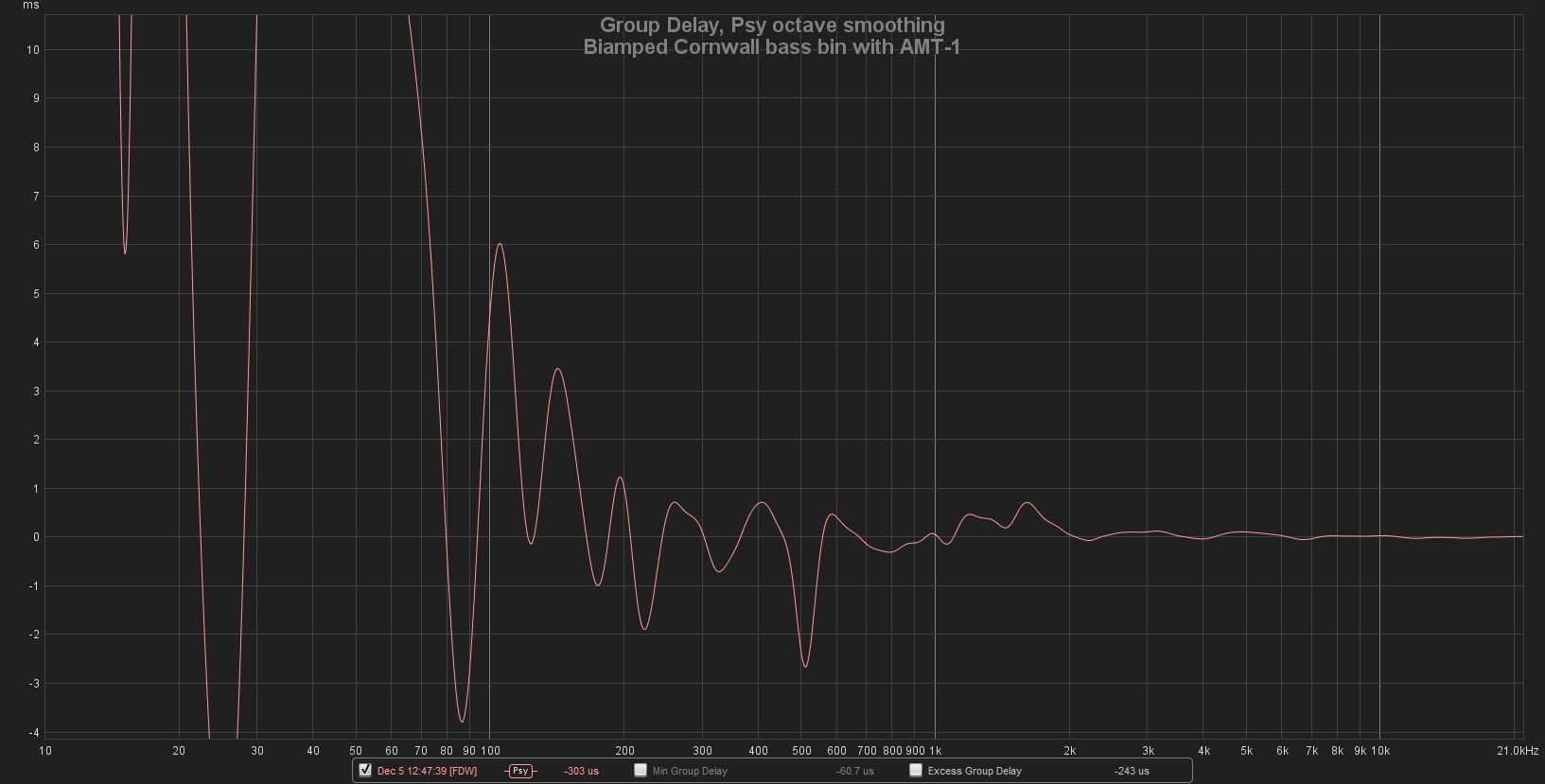
And the impulse spectrogram:
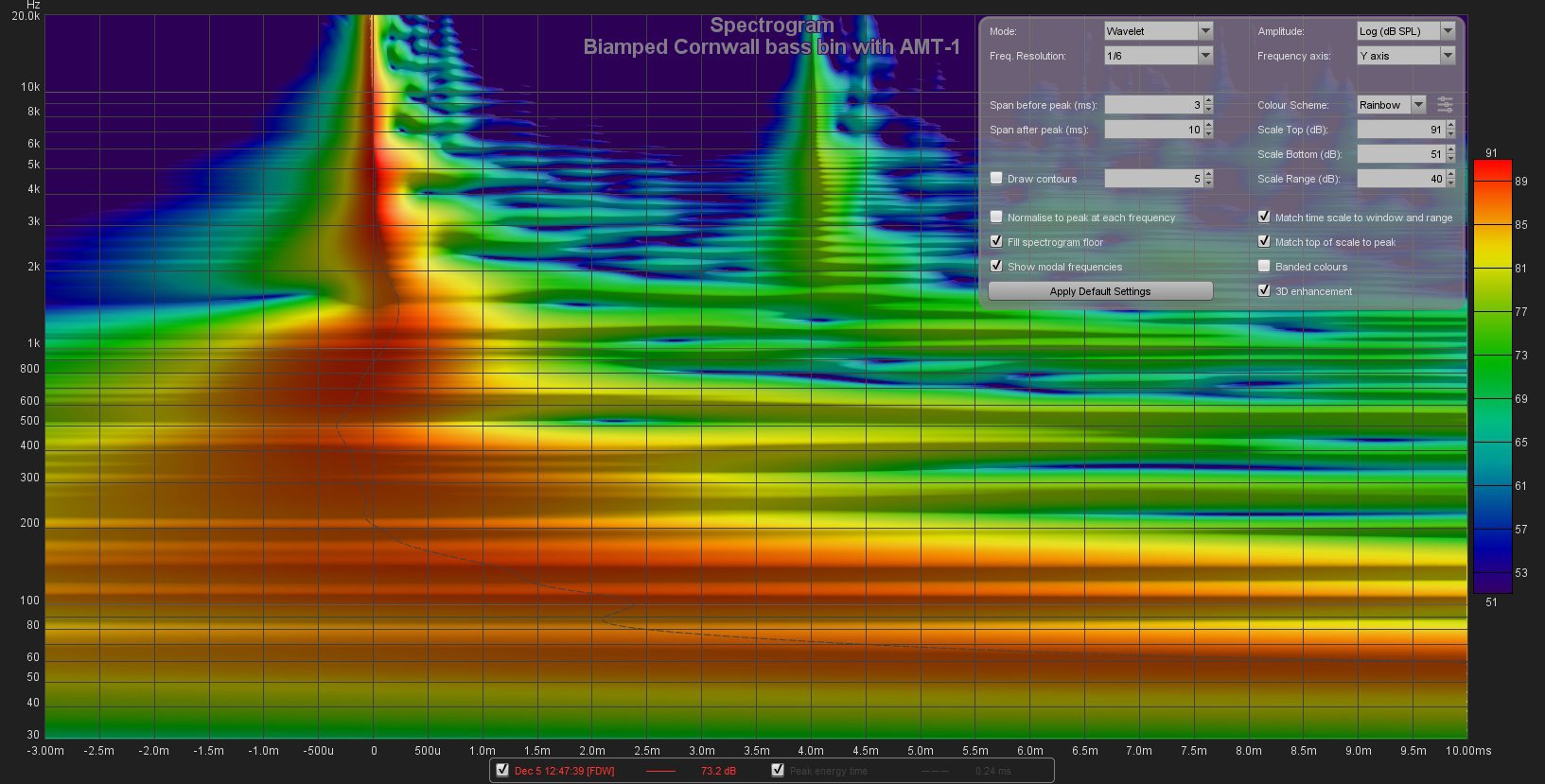
And finally, the step response:

Chris

And the impulse spectrogram:

And finally, the step response:

Chris
- Status
- Not open for further replies.
- Home
- Loudspeakers
- Multi-Way
- How to improve step response
